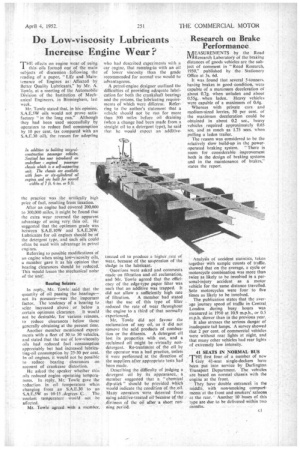Do Low-viscosity Lubricants Increase Engine Wear?
Page 37

If you've noticed an error in this article please click here to report it so we can fix it.
THE effects on engine wear of using thin oils formed one of the main subjects of discussion following the reading of a paper, "Life and Maintenance of Engines as• Affected by Better Quality Lubricants," by Mr. A. Towle, at a meeting of the Automobile Division of the Institution of Mechanical Engineers, in Birmingham, last week.
Mr. Towle stated that, in his opinion, S.A.E.5W oils would not prove satisfactory " in the long run." Although they had been used successfully by operators to reduce fuel consumption by 10 per cent. (as compared with an S.A.E.30 oil), the reason for adopting the practice was the artifically high price of fuel, resulting from taxation.
After an engine had covered 200,000 to 300,000 miles, it might be found that the extra wear reversed the apparent advantage of using very thin oil. He suggested that the optimum grade was between SA.E.10W and S.A.E.20W. Lubricants' for oil engines should be of the detergent type, and such oils could often be used with advantage in petrol engines.
Referring to possible modifications of an engine when using low-viscosity oils, a member gave it as his opinion that bearing clearances should be reduced. This would lessen the Mechanical noise of theunir.
Bearing Seizure.
.In repl-y,, Mr. Towle said that the quantity of •oil passing the bearings— not its pressure—was the important factor. The tendency, of a bearing to . seize increased .above or below a. _certain optimum Clearance. it would. not be desirable,. for various reasons, to reduce clearances below those generally obtaining at the present time.
Another member mentioned experiments with a fleet of 30 to 50 vehicles, and stated that the use of low-viscosity oils had reduced fuel consumption aPpreciably but had increased lubricating-oil consumptionby 25-30 per cent. In oil engines, it would not be possible to . reduce bearing clearances • on account of crankcase distortion. •
He asked the speaker whether thin oils reduced engine operating temperatures. In reply, Mr. Towle gave the reduction, in oil temperature when changing from an S.A.E.30 to an
S.A:E.5W. as .111-15-.,,degrees The ..'eoolant temperature Wmild not be
affected. . • .
• Mr, .Towle agreed with a member, who had described experiments with a car engine, that running-in with an oil of lower viscosity than the grade recommended for normal use would he advantageous.
A petrol-engine designer outlined the difficulties of providing adequate lubrication for both the crankshaft bearings and the pistons, the lubricating requirements of which were different. Referring to the author's statement that a vehicle should not be run for more than 500 Miles before oil draining (when a change had been made from a straight oil to a detergent type), he said that he would expect an additive
treated oil to produce a higher rate of wear, because of the suspension of: the sludge in the lubricant.
Questions were asked and comments made on filtration and oil reclamation, and Mr. Towle agreed that the efficiency of the edge-type paper filter was such that an additive was trapped. It did not allow a sufficiently high rate
of filtration. A member had stated that the use of this type of filter reduced the rate of wear throughout the engine to a third of that normally experienced.
Mr. Towle did not favour the reclamation of any oil, as it did not remove the acid products of combus
tion or the diluents. A detergent oil lost its properties with use, and a reclaimed oil might • be -virtually nondetergent. Re-treatment of the oil by the operator was a bad practice, unless it were performed at the direction of the suppliers after appropriate tests had been made.
Describing the difficulty of judging a detergent oil by its appearance, a member suggested that a "chemical dip-stick" should be provided which would indicate the condition of the oil. Many operators were deterred from using additive -treated oil because of the dirtiness of the oil after a short running peritid.-
























































































